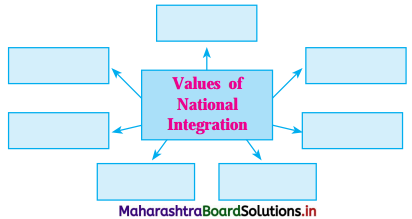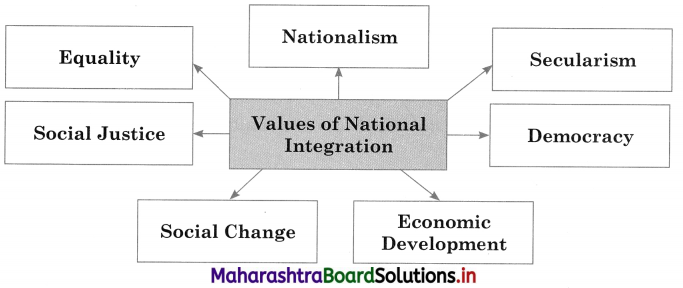Balbharti Maharashtra State Board Class 12 Political Science Solutions Chapter 4 Contemporary India: Challenges to Peace, Stability and National Integration Textbook Exercise Questions and Answers.
Maharashtra State Board Class 12 Political Science Solutions Chapter 4 Contemporary India: Challenges to Peace, Stability and National Integration
1. (A) Complete the following statements by selecting the appropriate option.
Question 1.
Article had granted a ‘special status’ to Jammu and Kashmir.
(a) 352
(b) 360
(c) 370
(d) 110
Answer:
(c) 370
![]()
Question 2.
Left wing Extremism originated in 1967 in
(a) Nagaland
(b) Jharkhand
(c) Gadchiroli
(d) Naxalbari
Answer:
(d) Naxalbari
(B) Identify the incorrect pair in every set and correct it.
Question 1.
(a) Naxalism – Red Corridor
(b) CPI (Maoist) – Uri attacks
(c) Assam – Sons-of-soil movement
Answer:
(b) Jaish-e-Mohammed – Uri attacks
Question 2.
(a) Boko Haram – Ireland
(b) LTTE – Sri Lanka
(c) ETA – Spain
Answer:
(a) Boko Haram – Nigeria
OR
IRA – Ireland
(C) Complete the following statements by using appropriate reason.
Question 1.
The left wing extemists prevent execution and implementation of developmental work, because ……………..
(i) they are against government.
(ii) the opposition parties ask them to do so.
(iii) they want to show that the government structure at field level is ineffective.
Answer:
(ii) the opposition parties ask them to do so.
![]()
Question 2.
In 1990’s Kashmiri Pandits migrated from Kashmir valley, because …………………..
(i) they weren’t from Kashmir.
(ii) there was growth in Islamic militancy.
(iii) there were no job opportunities for them.
Answer:
(i) they weren’t from Kashmir.
2. (A) Find the odd word.
Question 1.
Terrorism, Naxalism, Nationalism, Extremism.
Answer:
Nationalism (not a violent activity)
(B) State the appropriate concept for the given statements.
Question 1.
Threat use violence with an intention to create panic in the society.
Answer:
Terrorism
Question 2.
Involvement of people in decision making process of State.
Answer:
Good Governance
3. (A) Complete the concept maps.
Question 1.

Answer:

![]()
(B) State whether the following statements are true or false with reason.
Question 1.
Democracy is required to establish national integration and social transformation.
Answer:
This statement is True.
- Democracy and national integration are complementary, since the core of the structural aspect of national consolidation is the democratic system of governance.
- Participation of diverse socio-cultural groups in the process of governance is possible only through a representative democratic system. Democracy helps in political participation and social transformation by removing ethnic, caste and gender inequality.
Question 2.
National movement in India played an important role in national integration.
Answer:
This statement is True.
- The national freedom movement extended across the length and breadth of the country and involved people of different religions, regions and cultures.
- It played a vital role in bringing Indians together emotionally and politically into a nation and integrating them in a common frame work of political identity and loyalty.
![]()
4. Explain the correlation between the following.
Question 1.
National Unity and Regional Aspirations
Answer:
National Unity is possible when citizens of that State exhibit psychological oneness, solidarity and shared values. It is not homogeneity but a form of ethnic, religious and linguistic acceptance. Regional aspirations occur in forms like demand for separate States, language issues, etc., Regional aspirations have their roots in historical/linguistic/cultural issues or may be a product of regional political outfits. Sometimes, regional aspirations may even become secessionist as in case of Khalistan movement. India has tried to reconcile regional aspirations with national unity by creating a federation with a strong centre, creating of smaller States as well as the linguistic reorganisation of States.
5. Express your opinion of the following.
Question 1.
Peace and stability are necessary for the nation’s progress.
Answer:
Peace, stability and public order are necessary for nation’s progress and good life of citizens. An unruly society will lead to violence, loss of life, destruction of property, economic and political instability. Conflict resolution is linked to maintenance of law, order and peace. In the absence of order and stability, divisive tendencies will prevail, infrastructure will be targeted, investments will be discouraged thus becoming a barrier to economic growth. At a basic level, political stability is ensured using constitutional machinery and socio-economic development. In case of any problem occurring, the State tries to resolve it peacefully. In case the issue escalates or becomes violent, the State may employ force if necessary.
![]()
6. Answer the following question in 80 to 100 words.
Question 1.
What is Left Wing Extremism in India?
Answer:
Left Wing Extremism (also called Maoist movement or Naxalism) has major support base among landless labourers, dalits and tribals who experience a sense of oppression, injustice and neglect. The first attempt to promote a peasant struggle was the Telangana Movement (1946-51). The Naxal Movement originated in 1967 in Naxalbari (West Bengal) led by Kanu Sanyal and writings of Charu Majumdar.
Since 1980s the movement has taken a militant turn. In 2004 CPI (M-L), People’s War Group (PWG) and Maoist Communist Centre (MCC) of India merged to form CPI (Maoist) which aims to overthrow the government, Naxal activities aim to destroy public property and attack police and officials. The Red Corridor of naxal activities extends across States like Bihar, Jharkhand, Chhattisgarh, Maharashtra, Telangana, Andhra Pradesh, etc.
Some of their broad tactics are as follows:
- Use of propaganda slogans
- Establishment of mass movements
- Mobilisation of women, tribals and minorities into the revolution
- Mobilisation of urban population on mass issues
- Develop appropriate forms of military organisation
![]()
Question 2.
Explain cross border terrorism in Jammu and Kashmir.
Answer:
The India Independence Act (1947) provided that princely States (562 existed then) could decide to join either Pakistan or remain independent. Maharaja Hari Singh of the Dogra dynasty delayed such a decision. In 1947, Kashmir’s population was 77% Muslim and 20% Hindu. The problem in
the region began when Pakistan sent Pashtun tribal raiders in October 1947 to force Hari Singh to join Pakistan. However, the Maharaja appealed to India for help and signed the Instrument of Accession making the State as a part of India.
The Government of India sent troops to the region to drive away the infiltrators. This led to the first India-Pakistan conflict (1947-48). In 1965, Pakistan attacked India but the local Kashmiri population did not support Pakistan. In 1965, Amanullah Khan created the Plebiscite Front in Pakistan Occupied Kashmir. It’s militant wing i.e., National Liberation Front carried out sabotage activities in Jammu and Kashmir.
In 1977, the Plebiscite Front was renamed Jammu and Kashmir Liberation Front (JKLF). Similarly, Pakistan lent support to guerilla outfits in the region like Hizb-ul-Mujahideen. In the 1990s, as instances of militancy increased, the minority Pandit population was forced to flee from Kashmir. At this time, local insurgency grew into terrorism sponsored by Pakistan and having training camps in Pakistan Occupied Kashmir. Pan-Islamic terrorist groups like Lashkar-e-Taiba, Hizbul, etc., and several Pakistan based persons like Hafeez Sayed have promoted terror activities and radicalisation of the local population. In recent years stone pelting by young protestors has increased.
7. Answer the following in 150 to 200 words.
Explain the role of the State with help of given points.
(a) Peace and order
(b) Economic development
(c) National Building
(d) Governance
(e) Welfare
Activity
Trace the changes that have taken place in Art 370 of the Indian constitution.
![]()
Class 12 Political Science Chapter 4 Contemporary India: Challenges to Peace, Stability and National Integration Intext Questions and Answers
Activity (Text Book Page No. 39)
Question 1.
What are the Fundamental Duties enshrined in the Indian constitution?
Answer:
To spread awareness about them, fundamental duties were inserted in the Part IV Article 51(A) of the Constitution by the 42nd Constitutional Amendment, 1976.
The fundamental duties include:
- To abide by the Constitution and respect the National Flag and National Anthem.
- To cherish and follow the noble ideas which inspired our national struggle for freedom.
- To respect and protect the sovereignty, integrity and unity of India.
- To defend and serve the country.
- To promote harmony and the spirit of common brotherhood amongst all the people of India and to abolish evils hampering women’s dignity.
- To value and preserve the rich heritage of our composite culture.
- To protect and improve the natural environment including forests, rivers, trees, lakes and to show kindness towards animals.
- To develop scientific temper and spirit of inquiry.
- To protect public property and prevent violence.
- To strive towards excellence in all spheres of individual and collective activity.
- A parent or guardian should provide opportunities for education to his child, between the age of 6 to 14 years. (This has been added by 86th Constitutional Amendment)
![]()
Question 2.
Find out the details of the following events and discuss them in the classroom:
(i) Assam Oil Blockade (1980)
(ii) Assassination of Rajiv Gandhi (1991) (Text Book Page No.41)
Answer:
(i) Assam Oil Blockade (1980)
The Assam Movement (1979-1985) led by the All Assam Students Union (AASU) and All Assam Gana Sangram Parishad (AAGSP) was against the illegal immigrants in Assam. There were a series of protests to compel the government to identify and expel illegal immigrants (mostly Bangladeshi) and to provide safeguards to the indigenous Assamese. Some of the protests were violent e.g., the Nellie massacre (1983). On 15th August 1985, the Assam Accord was signed between the Rajiv Gandhi Government and leaders of the Assam movement by which all migrants who had entered the State prior to January 1, 1966 were accepted.
The Oil Blockade was part of the Assam agitation. Crude oil from Assam was pumped to a refinery at Barauni (Bihari). However, AASU protested and blockaded oil supply in 1980. A committee was appointed to suggest a new location for refinery within Assam. They suggested Bongaigaon near West Bengal border. The oil blockade resulted in huge losses to the petroleum industry.
(ii) Assassination of Rajiv Gandhi (1991)
Assassination of Rajiv Gandhi, former Prime Minister of India (1984-1989) occurred as a result of suicide bombing in Sriperumbudur, Chennai on 21st May 1991. It was carried out by a member of LTTE (Sri Lanka) known as Thenmozhi Rajaratnam (Dhanu) At least 14 others were killed in the explosion of the RDX laden belt by Dhanu. The assassination was attributed to LTTE being antagonised by Mr. Rajiv Gandhi’s sending of Indian Peace Keeping Force (IPKF) to Sri Lanka and the signing of the Indo-Sri Lanka Peace Accord with President J. Jayewardene in 1987.